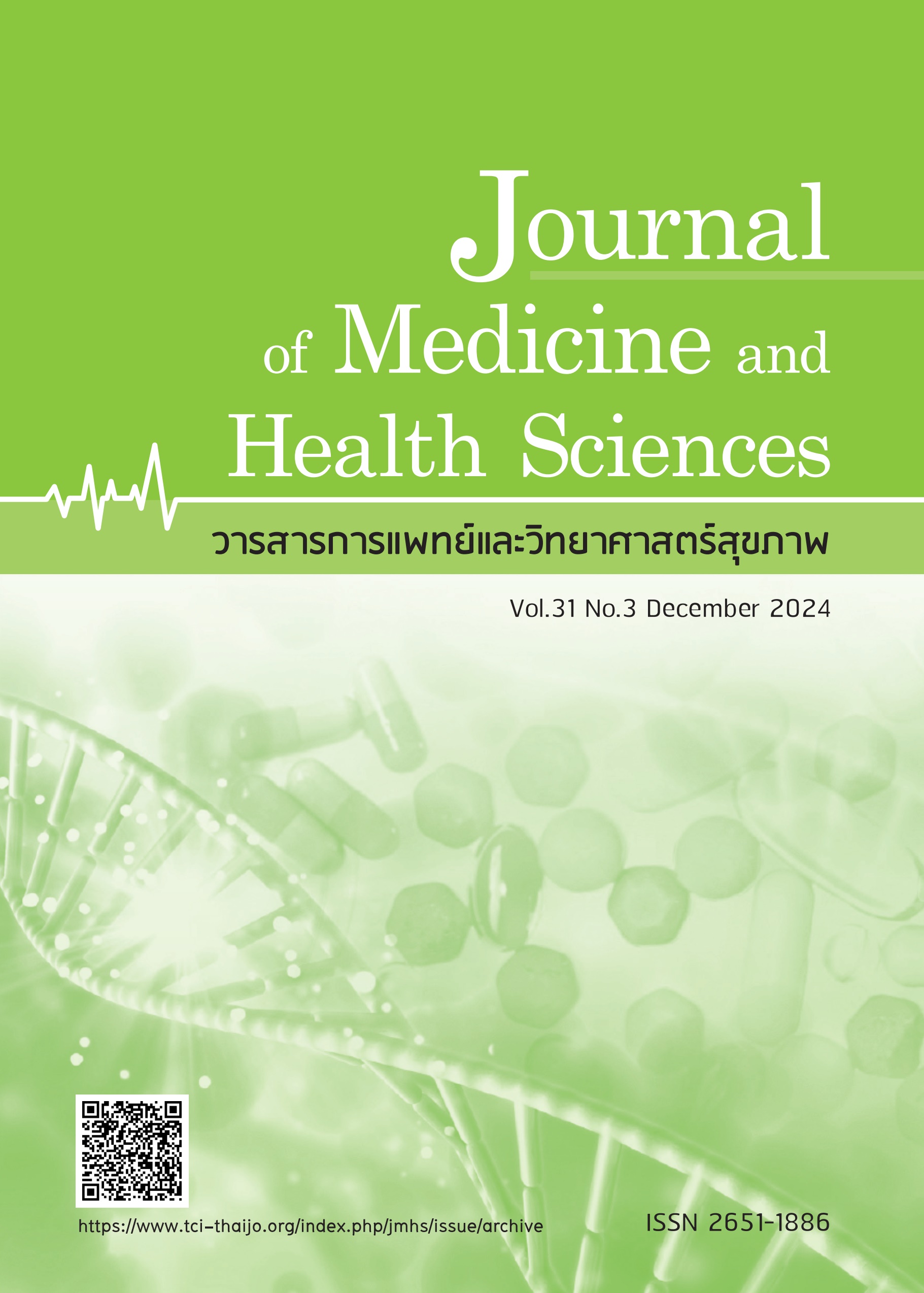Comparison of subject acceptance in electroretinographic testing using contact lens and DTL electrodes with RETI-port/scan 21 to establish normative data at Siriraj Hospital
Keywords:
acceptance with using electrode, contact lens electrode, Dawson - Trick - Litzkow electrode, electroretinographic testAbstract
Electroretinography is a test that measures retinal impulses resulting from the activity of both neural and non-neural retinal cells, which can be recorded using various electrodes. However, there are no reports regarding the acceptance and sensations associated with the use of contact lens electrodes (CL electrodes) and Dawson-Trick-Litzkow electrodes (DTL electrodes). This study compares the acceptance and sensations of volunteers using CL and DTL electrodes with the RETI-port/scan 21 machine at Siriraj Hospital. A questionnaire was administered to 20 volunteers with no history of ocular conditions or medication affecting the eyes, as part of the Eye Checkup Project aimed at establishing normative data for electrophysiological tests at Siriraj Hospital. Eighty-five percent of volunteers reported no symptoms with the DTL electrode, while 25% experienced mild irritation and 15% found it annoying. With the CL electrode, 50% of volunteers reported no symptoms, 35% experienced irritation, and 25% felt annoyance. Additionally, some volunteers reported discomfort, difficulty blinking, and dryness with the CL electrode. Fifty-five percent preferred the DTL electrode over the CL electrode, while 20% were comfortable using both. Redness was observed in 15% of volunteers for both electrode types, but pain was reported only with the CL electrode (3%). Overall, volunteers showed greater acceptance of the DTL electrode due to less discomfort and difficulty blinking, with the differences being statistically significant.
References
Ruangvaravate N, Thuangtong A, Saksiriwutto P. Electrophysiologic tests of vision. Bangkok: Department of Ophthalmology Faculty of Medicine Siriraj Hospital, Mahidol University; 2018. p.71-81. (in Thai)
Thuangtong A, Chuenkongnaew W, Singalavanija A. Basic knowledge of ophthalmology. Bangkok: Department of Ophthalmology Faculty of Medicine Siriraj Hospital, Mahidol University; 2015. p.61-9. (in Thai)
Robson AG, Frishman LJ, Grigg J, et al. ISCEV Standard for full-field clinical electroretinography (2022 update). Doc Ophthalmol 2022;144:165-77. doi:10.1007/s10633-022-09872-0.
Robson AG, Nilsson J, Li S, et al. ISCEV guide to visual electrodiagnostic procedures. Doc Ophthalmol 2018;136:1-26. doi:10.1007/s10633-017-9621-y.
Rungsiri K, Homchong N, Thuangtong A, et al. Normative data of the electrophysiologic tests at Siriraj hospital. Siriraj Med Bull 2020;13:247-52. (in Thai)
Sinawat S. Common retinal and vitreous disease. Khon Kaen: Department of Ophthalmology Faculty of Medicine, Khon Kaen University; 2016. p.75-80. (in Thai)
Dezheng W, Yan L. Atlas of testing and Clinical application for ROLAND electrophysiological instrument. China: Beijing Science and Technology; 2013.
Man TTC, Yip YWY, Cheung FKF, et al. Evaluation of electrical performance and properties of electroretinography electrodes. Transl Vis Sci Technol 2020;9:45. doi:10.1167/tvst.9.7.45.
Thuangtong A, Ruangvaravate N, Samsen P, et al. Narmative data of electroretinogram and visual evoked potential in Thai population. Siriraj Med Journal 2007;59:131-4. (in Thai)
Brouwer AH, de Wit GC, de Boer JH, et al. Effects of DTL electrode position on the amplitude and implicit time of the electroretinogram. Doc Ophthalmol 2020;140:201-9. doi:10.1007/s10633-019-09733-3.
Kurtenbach A, Kramer S, Strasser T, et al. The importance of electrode position in visual electrophysiology. Doc Ophthalmol 2017;134:129-34. doi:10.1007/s10633-017-9579-9.
Gondosari TYP, Sidik M, Nusani S, et al. Comparison of wave amplitude, implicittime and comfort level using Dawson-TrickLitzow, Jet and Dencott electrodes in electroretinography in normal adults. IJRetina 2020;3:60-3. doi:10.35479/ijretina.2020.vol003.iss002.123.
Lapkovska A, Palmowski-Wolfe AM, Todorova MG. Comparing DTL microfiber and neuroline skin electrode in the Mini Ganzfeld ERG. BMC Ophthalmol 2016;16:137. doi:10.1186/s12886-016-0311-4.
RETI-port/scan 21 User manual. Roland consult electrophysiology and imaging. 2018; p.30.
Rungsiri K. Eye checkup of Thalassemia disease. Bangkok: Department of Ophthalmology Faculty of Medicine Siriraj Hospital, Mahidol University; 2021. p.34-5. (in Thai)
Downloads
Published
How to Cite
Issue
Section
License
Copyright (c) 2024 Journal of Medicine and Health Sciences

This work is licensed under a Creative Commons Attribution-NonCommercial-NoDerivatives 4.0 International License.



